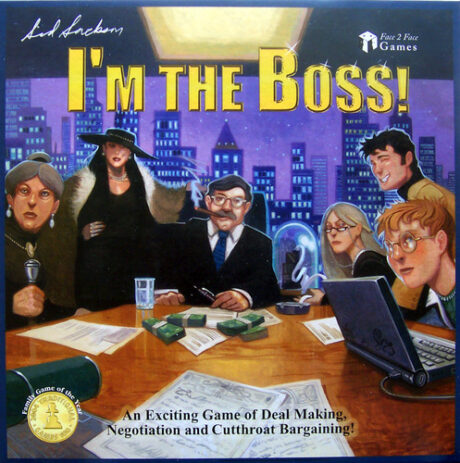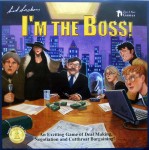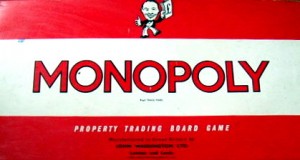- Learning time
- 20 minutes
- First play time
- 90 minutes
I´m the Boss
Designed by: Sid Sackson
If the faintly cheese-whiffy box art and character cards put you in mind of a late-twentieth century Hollywood version of big business, so much the better; I’m the Boss is a classic negotiation game from the mid-nineties, and wears its heritage proudly.
Players represent, well, representatives – legal and business representatives of six wealthy clients (investors), attempting to do deals with each other and come out on top. Each player starts the game with one of these investor cards in front of them, representing a permanent relationship with this client. There’s a big stack of cards from which each player is dealt a hand; there’s a bank and a main board, almost Monopoly-like, with a giant dollar-sign counter that is moved from space to space. Each space on the board shows a potential deal to be done, involving 2 to 5 of the investors, and the amount of money there is to be shared in the deal. On a players turn they can attempt to make one of these deals, or simply draw more cards, bolstering their hand for future shenanigans.
The deals are simple – there might be a deal involving the representatives of Dougherty and Goldman, worth 3 shares. The current share value (which increases during the game) might be $4 million, meaning the deal is worth $12 million total, to be divided between two players. The boss, the current player, might have in front of them the Dougherty investor card. They could suggest to the player with the Goldman investor card that they strike a deal – perhaps $8 million to themselves, $4 million to the Goldman investor. The Goldman investor might agree. So far so simple.
However, at any time, any player can jump in with a card from their hand. This might simply be an alternate (non-permanent) Goldman card – perhaps you’d rather do the deal with me, as I now also represent Goldman for this deal? That player might also play a card sending the other Goldman away on a trip, meaning he’s no longer available – now you do the deal with me or it doesn’t get done at all. Until yet another player plays a Goldman card. There are cards that can steal the permanent investor card from a player, and ‘stop’ cards that cancel cards as they are played. It’s more than likely any deal will involve multiple representatives of the investors, all vying for a share of the deal – but eventually, a deal will be agreed, and the boss will count down from ten to ensure no more interference; the deal is done, the money shared out.
Of course, someone might decide, just as the clock is ticking down, to play an I’m the Boss card. Suddenly, they’re the boss of the deal, and negotiations must be with them! The original boss might play a stop card, but that might be over-ridden by a second I’m the Boss card – maybe from yet another player, who’s been lurking in the shadows, waiting until the stop cards have been flushed out. You get the picture – it’s mayhem, and successfully creates a real feeling of corporate sharkery.
The game will end after between nine and fifteen deals, and the winner will be the player with the most cash. It’s not a terribly serious game, with huge swings of fortune and a lot resting on the payout of the last few deals – but with the right crowd, in the right mood, it’s sure to unleash your inner Gordon Gekko.
Joe says
I really enjoy this - it feels like a classic board game from the 90s, probably because it is. Lots of luck, lots of deals and counter-deals; and just as you're about to make strike it, someone wades in and takes over - everyone groans, and you try desperately to cling to at least some share of the spoils. You do need five or six players to make it a proper bunfight.
The guru's verdict
-
Take That!
Take That!
Yes, yes and YES! I'm the Boss is hugely back-stabby and score-settly - it's absolutely the nature of the game, and only fun if you enjoy whipping the rug out from under people, and having it whipped out from under you.
-
Fidget Factor!
Fidget Factor!
There can be some downtime if you're not actively involved in a deal - the game shows its age here a little; and if someone else takes ovber and becomes the Boss, you can miss out on a turn completely. But for every tense deal, there will be rounds where everyone is simply taking cards, so there's an ebb and flow to the pace.
-
Brain Burn!
Brain Burn!
Trying to keep tabs on who has earned what, who's the perceived leader and who's really calling the shots, could be draining. Probably easier to go with the gut, and just try and be a part of as many deals as you can.
-
Again Again!
Again Again!
It's a fairly one-note game; it'll probably come out a few times a year when all present are in the mood for a big old ding-dong.







Sam says
I'm not a huge fan of this - I don't really warm to games where a card is played and the parameters of everything change in unexpected and allegedly hilarious ways. That feels to me like a mechanic suitable to a ten minute game rather than one that lasts an hour or more. But I should caveat that by saying I'm the only one in our gang of regular gamers who dislikes it. See Joe's commentary for the opposing take on it.